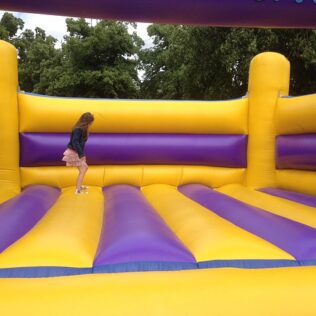While bounce houses are fun for children, parents need to be aware that they can be dangerous and could cause serious injuries. Improper installation and failure to properly supervise the children inside increases the risk of injury. This is negligence on the part of the company or event planner responsible for the inflatable attraction.
Bounce Houses and Other Inflatables Increasing in Popularity
Over the years, the popularity of bounce houses and inflatable attractions has grown. They can be found at carnivals, festivals, and at private events like kids’ birthday parties. With bright colors and whimsical designs, these attractions quickly draw the attention of young children because they look less threatening than other types of amusement rides.
Unlike most mechanical amusement rides, there is very little safety oversight or specific regulations pertaining to bounce house use. Only half the states in the country have regulations that govern permits, inspections, and insurance. However, Indiana is not one of these states.
The price of inflatables has dropped as their availability for purchase has increased. Some can be purchased online or at retailers for under $1,000. There has been an increased number of people who enter the industry of renting bounce houses and other inflatables without training or experience. This puts kids at even more risk for serious personal injuries and deaths because of operator negligence.
Number of Bounce House Injuries Soar
As the use of inflatable amusements such as bounce houses increases, so has the number of injuries related to their use. A Consumer Product Safety Commission (CPSC) report estimates that the number of bounce house injuries soared from 5,311 in 2003 to 17,377 in 2013. Twelve deaths from bounce house injuries also occurred during that same period. The CPSC also reports that between 2008 and 2013, 82,203 people were injured from inflatables with more than 90 percent being from bounce houses. That number is based on emergency room visits and does not include those who were injured and did not seek medical care.
A Stateline report estimates that almost 21,000 injuries now occur each year, while Pediatrics journal claims that a child gets injured from a bounce house every 46 minutes. The authors of the Pediatrics’ report went as far as calling bounce house injuries an epidemic and similar to those that are sustained on backyard trampolines. This is significant because the American Academy of Pediatrics recommended that children should not be allowed to play on trampolines in 2012.
How Do Bounce House Injuries Occur?
There have been multiple reports of bounce houses toppling over or taking flight because of wind gusts. This usually happens because the bounce houses were not secured properly to the ground. Once they take flight they can blow into buildings, electric wires, cars, or continue to roll around for hundreds of feet. Those inside can be seriously or fatally injured. There have been instances where children have been killed after falling out of bounce houses that have been lifted by wind gusts.
Sudden deflation of bounce houses poses a suffocation risk when children become trapped in the heavy plastic as the structure collapses. This can happen when generators that power the inflatables run out of gas or when electrical circuits are tripped from those that run on electricity.
However, the most common reason why injuries occur in bounce houses is because of the children inside. Too many children and not enough space to jump around can be a recipe for disaster. So can having a mix of different aged and different sized children in the inflatable at the same time. Smaller children can be seriously injured from collisions. Approximately one-third of children injured are under the age of 6.
Common Injuries from Bounce Houses
Injuries from bounce houses can range from mild to life-altering and catastrophic injuries, including
- Pinches,
- Scratches and cuts,
- Sprains and strains,
- Broken bones, some requiring surgery,
- Facial injuries, including broken noses and dental injuries, and
- Head injuries, including concussions and traumatic brain injuries requiring lifelong medical care
Keeping Children Safe in Bounce Houses
The best way to keep children safe when using bounce houses is to exercise common sense. Parents should keep their children away from bounce houses that do not appear to be well-maintained, properly tethered to the ground, overcrowded, or properly supervised. Bounce houses should be avoided during poor weather and windy conditions. When no adults are present, the inflatable should be deflated.
Adult supervision is critical to keeping children safe in an inflatable. Children should be instructed not to engage in horseplay inside the bounce house and not to jump too close to others. Participants should remove footwear, eyeglasses, and jewelry before entering bounce houses to prevent puncture injuries.

